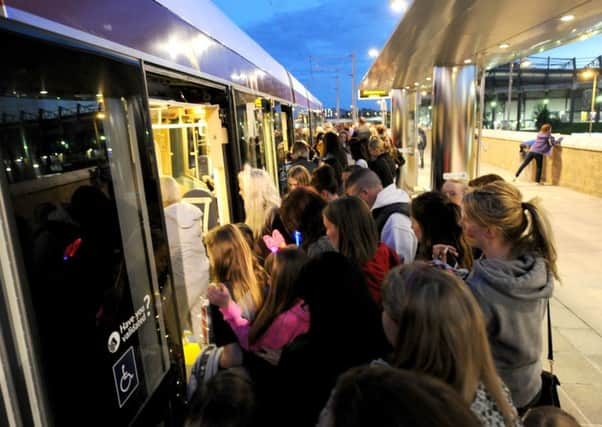Extra trams for Edinburgh to meet demand considered


Frequency may be stepped up after passenger growth outstripped expectations.
Around five million journeys a year are being made on the Edinburgh Airport to city centre line, with traffic in June up 5 per cent on last year.
Advertisement
Hide AdAdvertisement
Hide AdSpeeding up journeys is also being examined, along with earlier trams from the airport and additional Sunday services.
The moves came as some commuters complained about jam-packed peak-hour services.
One said: “It is standing room only, jammed against the doors, around rush hour westwards every single day, and the same at rush hour return at the end of the day. By the second stop in the morning, there are no seats.
“This existed way before the Edinburgh Festival, so it’s not tourism causing it – it’s basic demand.”
Trams currently run up to every eight minutes between 7am and 6:30pm, every ten minutes at other times and 12-15 minutes on Sundays.
The first city-bound tram leaves the Gyle shopping centre at 5am, but the first from the airport is not until 6:15am. Westbound services from the York Place terminus start at 5:30am.
Transport for Edinburgh, the city council body which runs Edinburgh Trams and Lothian Buses, signalled more frequent services were in the pipeline.
Chief executive Ian Craig said: “While some rush-hour trams have been extremely busy in recently weeks, we’re also seeing off-peak services filling up too, and we expect to be able to report some healthy passenger numbers soon.
Advertisement
Hide AdAdvertisement
Hide Ad“This is a good sign for the service and demonstrates the tram is growing in popularity.
“During these busy spells we do put extra trams into service.” He added: “But what I’m keen to do, on top of that, is to look at how we can increase frequencies further to ensure our customers receive the best possible service, and to take full advantage of the opportunities for the business.”
A total of 4.9 million passengers were carried in the first year to the end of May – 8 per cent above forecast. Accounts for 2014 show the system lost £449,000 in its first seven months compared to an expected £600,000.
However, these operating costs are on top of annual interest payments of some £15 million for 30 years on loans for completing the £776m, eight-mile line.
Experts welcomed more services but warned the city centre was already very congested during rush hours.
Planning consultant Robert Drysdale said: “Higher frequencies make the tram service more attractive as well as increasing capacity, so a higher peak-hour frequency of trams is a very desirable aim for Edinburgh.
“Unfortunately the very high flows of buses and other traffic at the east end of Princes Street result in a build-up of congestion during peak periods, which blocks the passage of the tram. As a result, delays to trams are a common occurrence on Princes Street throughout rush hours.
“If the tram frequency were to be increased, these problems would simply become even greater, and it is difficult to see how the additional tram movements could be accommodated, other than by reducing the volume of other traffic in the area.”
Advertisement
Hide AdAdvertisement
Hide AdTransport convener Lesley Hinds said: “We’re building up a clearer picture of demand all the time and will continue to work with Transport for Edinburgh to monitor and review the service to best fit customers’ needs.”